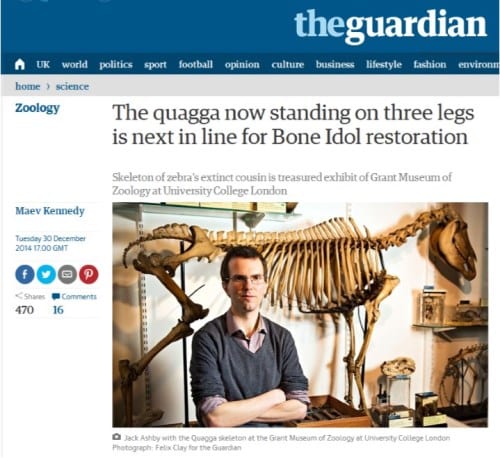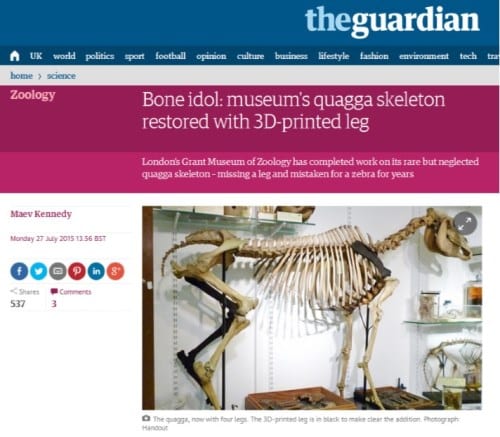Happy 132nd Quagga Day! It’s been a good year for quaggas
By Jack Ashby, on 12 August 2015
132 years ago today, 12th August 1883, the last quagga died, alone in her cage at Amsterdam Zoo.
The celebration/commeration of Quagga Day has become annual fixture at the Grant Museum, as we are one of only six or seven institutions worldwide to care for a quagga skeleton.
As such, we have written a lot about quaggas on this blog, and I won’t go into detail explaining what a quagga is, but for the uninitiated quaggas were a not very stripy kind of zebra that were hunted to extinction in their native South Africa for their unusual skins and as they competed with livestock for grazing grass.
Quaggas, we argue, are the rarest skeleton in the world, and we see our role at the Grant Museum as being global quagga champions.
For the first time in perhaps 132 years, I’m pleased to annouce that 2015 has been a very good year for quaggas.
Specifically it’s been a good year for the Grant Museum quagga – the only one on display in the UK.
Bone Idol
Our quagga started the year with a taste of media stardom, having appeared in a good number of news stories, including a high profile article in the Guardian reporting on our Bone Idols: Protecting our Iconic Skeletons conservation campaign, just before the skeleton left the Museum for her own treatment.
The project, centred on our quagga and rhino, aims to preserve 39 of our biggest and most significant skeletons for the long term future. The importance of the quagga was the real hook for the media success, and we are now well on our way, with 31 of the 39 objects completed.
Conserving the quagga
In May, we reported that our quagga had returned from an intensive few months undergoing major conservation. Specialist skeleton conservator Nigel Larkin had dismantled the invaluable specimen, chemically cleaned all her bones, removed some oozing black fatty deposits from the sternum, and remounted her on a new skeleton-friendly frame. Now our quagga’s neck is on the right way up, her leg meets her hip, her spine is accurately curved and her bones are not grimy.
As beautiful, shiny, and protected for the future as she was, our quagga still had a problem – she was missing a leg and a shoulder blade. This was about to change.
Quadrapedal quagga
While the skeleton was away from the Museum for her Bone Idols conservation, Nigel Larkin took an opportunity to CT-scan the one surviving hind limb and scapula at the Royal Veterinary College, who then mirrored the data to produce a digital version of the missing bones. Colleagues at UCL’s Bartlett School of Architecture then 3D printed the flipped scans, and Larkin assembled and attached the 21st century elements to the 19th century skeleton. The world’s rarest skeleton rides again on four legs. And happily, Maev Kennedy at the Guardian followed up her New Year article:
Carrying the quagga torch
One seventh (or one sixth, depending on if we can track down one that is eluding me) of the world’s quagga skeletons are now in a much better state than twelve months ago, meaning that generations to come will be able to learn the quaggas’ tragic story, and that is something to celebrate. We’re also pleased that this project has given this beautiful extinct animal some time in the limelight.
Join us, please, in raising a glass to the quagga, and other little-known species that have suffered at the hands of people. Happy Quagga Day.
Jack Ashby is Manager of the Grant Museum of Zoology
One Response to “Happy 132nd Quagga Day! It’s been a good year for quaggas”
- 1
 Close
Close






What a wonderful, heart-warming story. Well done (again) all at the Grant Museum!